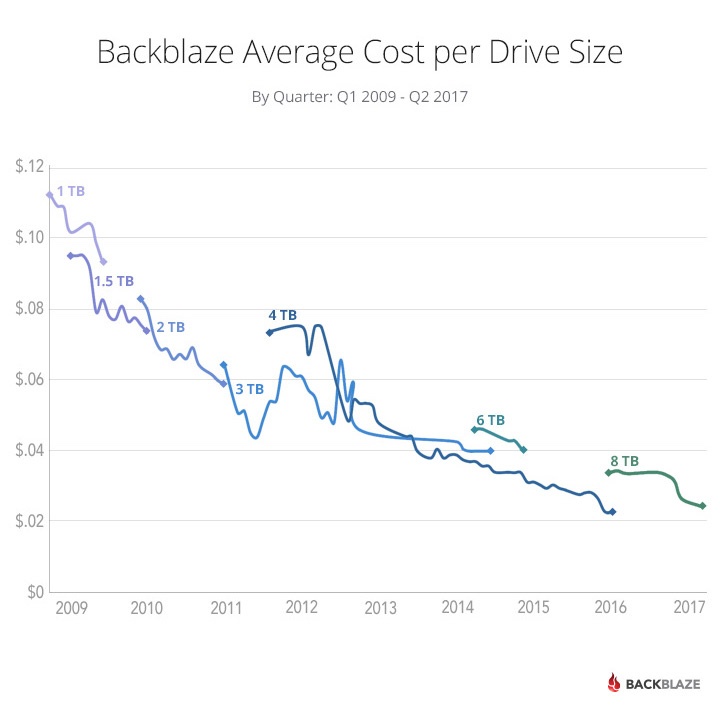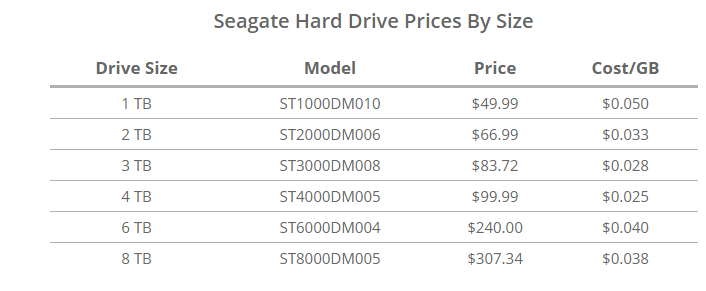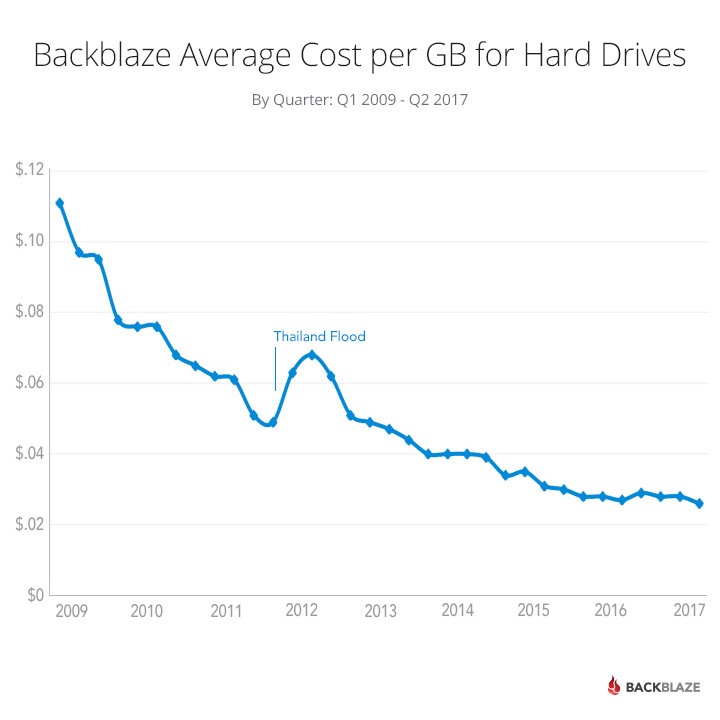Hard Drive Cost Per Gigabyte
For hard drive prices, the race to zero is over: nobody won. For the past 35+ years or so, hard drives prices have dropped, from around $500,000 per gigabyte in 1981 to less than $0.03 per gigabyte today. This includes the period of the Thailand drive crisis in 2012 that spiked hard drive prices. Matthew Komorowski has done an admirable job of documenting the hard drive price curve through March 2014 and we’d like to fill in the blanks with our own drive purchase data to complete the picture. As you’ll see, the hard drive pricing curve has flattened out.
75,000 New Hard Drives
We first looked at the cost per gigabyte of a hard drive in 2013 when we examined the effects of the Thailand Drive crisis on our business. When we wrote that post, the cost per gigabyte for a 4 TB hard drive was about $0.04 per gigabyte. Since then 5-, 6-, 8- and recently 10 TB hard drives have been introduced and during that period we have purchased nearly 75,000 drives. Below is a chart by drive size of the drives we purchased since that last report in 2013.

Observations
We purchase drives in bulk, thousands at a time. The price you might get at Costco or BestBuy, or on Amazon will most likely be higher.
The effect of the Thailand Drive crisis is clearly seen from October 2011 through mid-2013.
The 4 TB Drive Enigma
Up through the 4 TB drive models, the cost per gigabyte of a larger sized drive always became less than the smaller sized drives. In other words, the cost per gigabyte of a 2 TB drive was less than that of a 1 TB drive resulting in higher density at a lower cost per gigabyte. This changed with the introduction of 6- and 8 TB drives, especially as it relates to the 4 TB drives. As you can see in the chart above, the cost per gigabyte of the 6 TB drives did not fall below that of the 4 TB drives. You can also observe that the 8 TB drives are just approaching the cost per gigabyte of the 4 TB drives. The 4 TB drives are the price king as seen in the chart below of the current cost of Seagate consumer drives by size.

The data on this chart was sourced from the current price of these drives on Amazon. The drive models selected were “consumer” drives, like those we typically use in our data centers.
The manufacturing and marketing efficiencies that drive the pricing of hard drives seems to have changed over time. For example, the 6 TB drives have been in the market at least 3 years, but are not even close to the cost per gigabyte of the 4 TB drives. Meanwhile, back in 2011, the 3 TB drives models fell below the cost per gigabyte of the 2 TB drives they “replaced” within a few months. Have we as consumers decided that 4 TB drives are “big enough” for our needs and we are not demanding (by purchasing) larger sized drives in the quantities needed to push down the unit cost?
Approaching Zero: There’s a Limit
The important aspect is the trend of the cost over time. While it has continued to move downward, the rate of change has slowed dramatically as observed in the chart below which represents our average quarterly cost per gigabyte over time.

The change in the rate of the cost per gigabyte of a hard drive is declining. For example, from January 2009 to January 2011, our average cost for a hard drive decreased 45% from $0.11 to $0.06 – $0.05 per gigabyte. From January 2015 to January 2017, the average cost decreased 26% from $0.038 to $0.028 – just $0.01 per gigabyte. This means that the declining price of storage will become less relevant in driving the cost of providing storage.
Back in 2011, IDC predicted that the overall data will grow by 50 times by 2020, and in 2014, EMC estimated that by 2020, we will be creating 44 trillion gigabytes of data annually. That’s quite a challenge for the storage industry especially as the cost per gigabyte curve for hard drives is flattening out. Improvements in existing storage technologies (Helium, HAMR) along with future technologies (Quantum Storage, DNA), are on the way – we can’t wait. Of course we’d like these new storage devices to be 50% less expensive per gigabyte then today’s hard drives. That would be a good start.
75,000 New Hard Drives
We first looked at the cost per gigabyte of a hard drive in 2013 when we examined the effects of the Thailand Drive crisis on our business. When we wrote that post, the cost per gigabyte for a 4 TB hard drive was about $0.04 per gigabyte. Since then 5-, 6-, 8- and recently 10 TB hard drives have been introduced and during that period we have purchased nearly 75,000 drives. Below is a chart by drive size of the drives we purchased since that last report in 2013.

Observations
We purchase drives in bulk, thousands at a time. The price you might get at Costco or BestBuy, or on Amazon will most likely be higher.
The effect of the Thailand Drive crisis is clearly seen from October 2011 through mid-2013.
The 4 TB Drive Enigma
Up through the 4 TB drive models, the cost per gigabyte of a larger sized drive always became less than the smaller sized drives. In other words, the cost per gigabyte of a 2 TB drive was less than that of a 1 TB drive resulting in higher density at a lower cost per gigabyte. This changed with the introduction of 6- and 8 TB drives, especially as it relates to the 4 TB drives. As you can see in the chart above, the cost per gigabyte of the 6 TB drives did not fall below that of the 4 TB drives. You can also observe that the 8 TB drives are just approaching the cost per gigabyte of the 4 TB drives. The 4 TB drives are the price king as seen in the chart below of the current cost of Seagate consumer drives by size.

The data on this chart was sourced from the current price of these drives on Amazon. The drive models selected were “consumer” drives, like those we typically use in our data centers.
The manufacturing and marketing efficiencies that drive the pricing of hard drives seems to have changed over time. For example, the 6 TB drives have been in the market at least 3 years, but are not even close to the cost per gigabyte of the 4 TB drives. Meanwhile, back in 2011, the 3 TB drives models fell below the cost per gigabyte of the 2 TB drives they “replaced” within a few months. Have we as consumers decided that 4 TB drives are “big enough” for our needs and we are not demanding (by purchasing) larger sized drives in the quantities needed to push down the unit cost?
Approaching Zero: There’s a Limit
The important aspect is the trend of the cost over time. While it has continued to move downward, the rate of change has slowed dramatically as observed in the chart below which represents our average quarterly cost per gigabyte over time.

The change in the rate of the cost per gigabyte of a hard drive is declining. For example, from January 2009 to January 2011, our average cost for a hard drive decreased 45% from $0.11 to $0.06 – $0.05 per gigabyte. From January 2015 to January 2017, the average cost decreased 26% from $0.038 to $0.028 – just $0.01 per gigabyte. This means that the declining price of storage will become less relevant in driving the cost of providing storage.
Back in 2011, IDC predicted that the overall data will grow by 50 times by 2020, and in 2014, EMC estimated that by 2020, we will be creating 44 trillion gigabytes of data annually. That’s quite a challenge for the storage industry especially as the cost per gigabyte curve for hard drives is flattening out. Improvements in existing storage technologies (Helium, HAMR) along with future technologies (Quantum Storage, DNA), are on the way – we can’t wait. Of course we’d like these new storage devices to be 50% less expensive per gigabyte then today’s hard drives. That would be a good start.
0 комментариев
Вставка изображения
Оставить комментарий